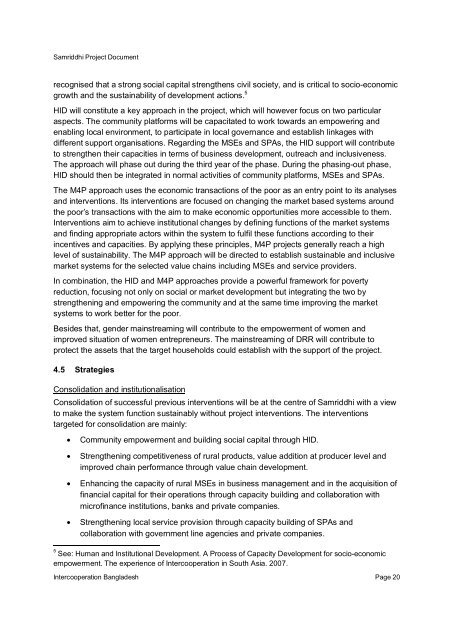Samriddhi
Samriddhi
Samriddhi
You also want an ePaper? Increase the reach of your titles
YUMPU automatically turns print PDFs into web optimized ePapers that Google loves.
<strong>Samriddhi</strong> Project Document<br />
recognised that a strong social capital strengthens civil society, and is critical to socio-economic<br />
growth and the sustainability of development actions. 5<br />
HID will constitute a key approach in the project, which will however focus on two particular<br />
aspects. The community platforms will be capacitated to work towards an empowering and<br />
enabling local environment, to participate in local governance and establish linkages with<br />
different support organisations. Regarding the MSEs and SPAs, the HID support will contribute<br />
to strengthen their capacities in terms of business development, outreach and inclusiveness.<br />
The approach will phase out during the third year of the phase. During the phasing-out phase,<br />
HID should then be integrated in normal activities of community platforms, MSEs and SPAs.<br />
The M4P approach uses the economic transactions of the poor as an entry point to its analyses<br />
and interventions. Its interventions are focused on changing the market based systems around<br />
the poor’s transactions with the aim to make economic opportunities more accessible to them.<br />
Interventions aim to achieve institutional changes by defining functions of the market systems<br />
and finding appropriate actors within the system to fulfil these functions according to their<br />
incentives and capacities. By applying these principles, M4P projects generally reach a high<br />
level of sustainability. The M4P approach will be directed to establish sustainable and inclusive<br />
market systems for the selected value chains including MSEs and service providers.<br />
In combination, the HID and M4P approaches provide a powerful framework for poverty<br />
reduction, focusing not only on social or market development but integrating the two by<br />
strengthening and empowering the community and at the same time improving the market<br />
systems to work better for the poor.<br />
Besides that, gender mainstreaming will contribute to the empowerment of women and<br />
improved situation of women entrepreneurs. The mainstreaming of DRR will contribute to<br />
protect the assets that the target households could establish with the support of the project.<br />
4.5 Strategies<br />
Consolidation and institutionalisation<br />
Consolidation of successful previous interventions will be at the centre of <strong>Samriddhi</strong> with a view<br />
to make the system function sustainably without project interventions. The interventions<br />
targeted for consolidation are mainly:<br />
• Community empowerment and building social capital through HID.<br />
• Strengthening competitiveness of rural products, value addition at producer level and<br />
improved chain performance through value chain development.<br />
• Enhancing the capacity of rural MSEs in business management and in the acquisition of<br />
financial capital for their operations through capacity building and collaboration with<br />
microfinance institutions, banks and private companies.<br />
• Strengthening local service provision through capacity building of SPAs and<br />
collaboration with government line agencies and private companies.<br />
5<br />
See: Human and Institutional Development. A Process of Capacity Development for socio-economic<br />
empowerment. The experience of Intercooperation in South Asia. 2007.<br />
Intercooperation Bangladesh Page 20
















